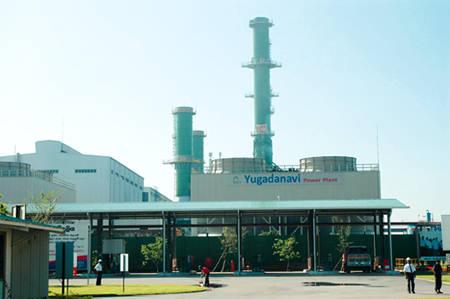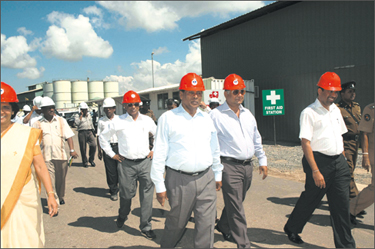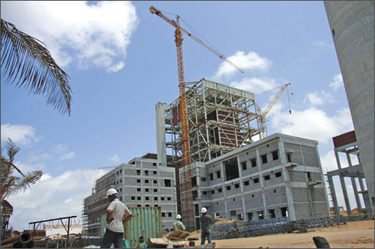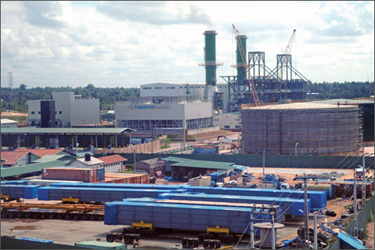|
First stage to be completed this month:
Electricity for all by 2012
by Shirajiv SIRIMANE and Nihal ABEYSINGHE
|

The Kerawalapitiya Combined Cycle Power Plant
|
The Ceylon Electricity Board, is the livewire that connects the power
sector in the country. It was founded in 1927 as the Department of
Government Electrical Undertakings.
Hydro electric power came into use in 1951 with the commissioning of
the Lakshapana project in the Central province. The demand for power
increased from approximately 20 megawatts in 1951 to nearly 73 megawatts
in 1963, about 90 percent of which was met from hydroelectricity
sources.
The United States and British-owned oil companies in Sri Lanka were
nationalised in 1963, and since then the importing, refining, and
distributing of all petroleum products has been the responsibility of
the Ceylon Petroleum Corporation.
In the 1970s, the island began to rely increasingly on imported oil
for the generation of electricity, but the new hydroelectric capacity
generated by the Mahaweli project in the 1980s reduced the importance of
oil.
In 1986 the total installed capacity was 1,010 megawatts, of which 74
percent was from hydropower.
In early 1988, it appeared that the Mahaweli project would solve Sri
Lanka's electricity problem in the foreseeable future.

Officials inspecting the progress |

Work in progress |
 |
This integrated power generation and irrigation project started
contributing to the National Grid in 1984 when the first two phases of
the Victoria Dam were completed, adding 140 megawatts to the installed
power capacity.
In April 1985, the final stage of the Victoria Dam increased the
power generation capacity by 70 megawatts. A slightly greater capacity
was expected in the late 1980s. Most of the power generation projects in
Sri Lanka were planned, funded and executed with foreign technical
expertise and assistance. However the Kerawalapitiya Power Plant is an
exception as it is Sri Lanka's first 100 percent 'Made in Sri Lanka'
major power plant project.
The project aims to construct a 270 MW Thermal Power Plant to boost
the supply of electricity in order to meet the growing demand in the
short term. The total investment for the project will be Rs. 34,267
Million.
The Construction of a 300 MW combined cycle power plant at a cost of
Rs. 71,000 Million too is under way.
The first stage of the project which would add 200 megawatts to the
national grid would be opened within a few weeks. It would be managed by
Yugadanavi Company as an associate of the CEB. In addition to this, the
other four major power projects are being implemented simultaneously and
some of them are already operational. The controversial 150 MW Upper
Kotmale hydro power project at a cost of Rs. 38,219 million is nearing
completion. This project did not get off the ground for over two decades
as there was no National leader to convince the environmentalists as
well the residents of the area of the benefits accruing to them and re
plan the project.
The Norochcholai Coal power project with a capacity of 1200 MW is
being constructed at an estimated cost of Rs. 51,550 million with
Chinese funds. The second Coal Power Project planing for Trincomalee
will be implemented at an estimated cost of Rs 60,000 million to
generate 500 MW electricity.
In addition, all transmission towers are being upgraded and
modernized while a sum of Rs 17,700 million is being spent for rural
electrification scheme to provide electricity for all in 2012.
The old Lakshapana and Ukuwela hydro power projects with the capacity
of 215 MW have been reconstructed. Accordingly the power capacity which
was 2400 GW in 2005 has been increased to 2690 GW in 2009. The number of
electricity consumers has been increased to 4.33 million in 2009 from
3.90 million in 2005. The percentage of number of house-holders with
power supply has increased to 84 % in 2009 from 76.7 percent in 2005. A
total of 7600 electricity development projects have been implemented
under various programs such as Gama Neguma, Maga Neguma Neganahira
Udanaya and Rajarata Navodaya.
With the aim of providing electricity for all by 2012, the government
has invested a total of Rs. 90,887 million in the power sector.
It may be interesting to note that the present focused development on
the power sector has outstripped all previous power projects in value,
man power and most importantly power generation capacity.
Work done in the power sector in the past 60 years have been
overtaken by the development achieved in the past four years which
clearly indicates the focus and commitment of the government to this
sector. The total power generation since President Mahinda Rajapaksa
took over was around 1000 megawatts and with the current power projects
expected to be completed in the next two years, Sri Lanka would have
over 2,600 mw of power which will sometimes enable it to export the
surplus. This a dream even the father of Sri Lanka is power generation,
G.W. Wimalasurendra would never have dreamt of such a situation which
most of the other Asian countries would envy.
|

